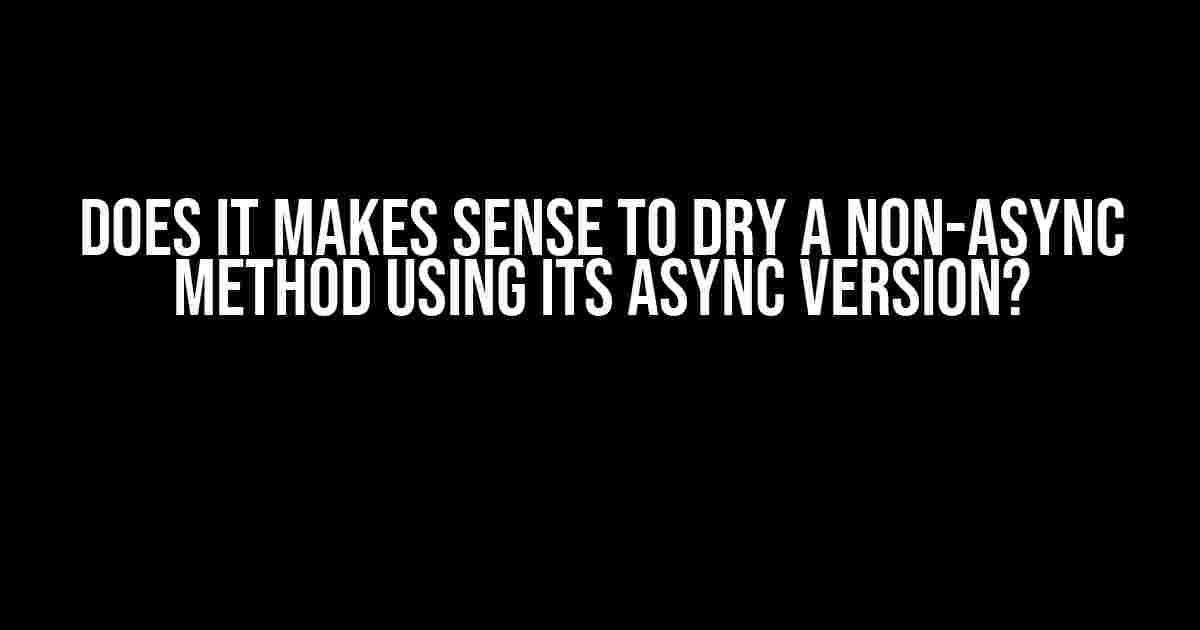As developers, we’re constantly looking for ways to optimize our code, making it more efficient, readable, and maintainable. One popular principle in software development is DRY (Don’t Repeat Yourself), which encourages us to avoid duplicating code. But what happens when we have a non-async method and its async counterpart? Should we DRY the non-async method using its async version? In this article, we’ll explore this question, weigh the pros and cons, and provide guidance on when it makes sense to do so.
Understanding Async and Non-Async Methods
Before we dive into the main topic, it’s essential to understand the difference between async and non-async methods.
- Non-Async Methods: These are traditional methods that execute synchronously, blocking the calling thread until they complete. They’re often used for tasks that don’t involve I/O operations or network requests.
- Async Methods: These are methods that execute asynchronously, allowing the calling thread to continue executing other tasks while the async method runs in the background. They’re commonly used for I/O-bound operations, such as database queries or network requests.
The DRY Principle
The DRY principle is a fundamental concept in software development that advocates for avoiding duplicated code. By reducing code duplication, we can:
- Reduce maintenance efforts
- Minimize bugs and errors
- Improve code readability
- Increase code reusability
In the context of async and non-async methods, the DRY principle suggests that we should reuse the logic of the async method in the non-async method to avoid duplicating code.
The Question: Should We DRY the Non-Async Method Using its Async Version?
Now that we’ve established the importance of the DRY principle, let’s examine the pros and cons of using the async method to DRY the non-async method.
Pros:
- Code Reusability: By using the async method, we can reuse the logic in both the async and non-async methods, reducing code duplication.
- Consistency: Implementing the async method in the non-async method ensures consistency in the code, making it easier to maintain and understand.
Cons:
- Performance Overhead: Using an async method in a non-async context can introduce performance overhead, as the method will still execute asynchronously, even if it’s not necessary.
- Complexity: Async methods can be more complex to implement and understand, especially for developers without experience with asynchronous programming.
- Blocking Calls: If the non-async method calls the async method synchronously (e.g., using .Wait() or .Result), it can lead to blocking calls, defeating the purpose of asynchrony.
When to DRY the Non-Async Method Using its Async Version
After weighing the pros and cons, it’s clear that using the async method to DRY the non-async method is not always the best approach. However, there are scenarios where it makes sense:
- Simple Async Operations: If the async method performs a simple operation that doesn’t involve I/O-bound or network-bound tasks, it might be acceptable to use it in the non-async method.
- Mocking or Testing: In testing or mocking scenarios, using the async method in the non-async method can simplify the implementation and reduce code duplication.
- Legacy Code: When working with legacy code, using the async method in the non-async method can help to modernize the codebase and reduce technical debt.
Best Practices for Implementing the Async Method in the Non-Async Method
If you decide to use the async method in the non-async method, follow these best practices:
- Use Task.Run(): Wrap the async method in a Task.Run() to ensure it executes asynchronously, even in a non-async context.
- Avoid Blocking Calls: Never use .Wait() or .Result to block the calling thread. Instead, use async/await or continuations to handle the async operation.
- Monitor Performance: Profile and monitor the performance of the non-async method to ensure the async method’s overhead doesn’t impact the application.
- Code Organization: Keep the async method and non-async method separate, using the async method as a utility function or a private helper method.
// Example of using Task.Run() to execute the async method
public void NonAsyncMethod()
{
Task.Run(async () => await AsyncMethod()).Wait();
}
public async Task AsyncMethod()
{
// Async logic here
}
Conclusion
In conclusion, while it’s tempting to DRY the non-async method using its async version, it’s essential to weigh the pros and cons and consider the specific scenario. By following best practices and carefully evaluating the trade-offs, you can make informed decisions about when to reuse the async method in the non-async method. Remember, the DRY principle is crucial, but it’s not a hard and fast rule; sometimes, it’s better to prioritize performance, readability, and maintainability over code reuse.
| Scenario | Use Async Method in Non-Async Method? | Why? |
|---|---|---|
| Simple Async Operations | Yes | Reduces code duplication and complexity |
| Mocking or Testing | Yes | Simplifies implementation and reduces code duplication |
| Legacy Code | Yes | Helps modernize the codebase and reduce technical debt |
| Performance-Critical Code | No | Async method overhead can impact performance |
| Complex Async Operations | No | Async method complexity can lead to maintenance issues |
By considering these factors and following best practices, you can make informed decisions about when to DRY the non-async method using its async version, ultimately writing more efficient, readable, and maintainable code.
Frequently Asked Question
Does it make sense to dry a non-async method using its async version? Let’s dive into the world of asynchronous programming and find out!
Q1: What’s the difference between async and non-async methods?
Async methods allow your program to continue executing other tasks while waiting for a response or I/O operation, making them super efficient! Non-async methods, on the other hand, block the execution of your program until the operation is complete. So, async is like a multitasking rockstar, while non-async is more like a sequential singer.
Q2: Why would I want to “dry” a non-async method?
“Drying” a non-async method means making it more concise and efficient by converting it to its async counterpart. You’d want to do this to avoid code duplication and make your codebase more maintainable. Think of it like refactoring your code to be more agile and flexible, like a yoga master!
Q3: What are the benefits of using async methods?
Async methods offer several benefits, including improved responsiveness, better system resource utilization, and enhanced overall performance. They allow your program to handle multiple tasks simultaneously, making it more efficient and scalable. It’s like having a team of super-productive elves working for you!
Q4: Are there any scenarios where using async methods wouldn’t make sense?
Yes, there are scenarios where async methods might not be the best choice. For example, if you’re working with real-time systems or applications that require strict sequential execution, async methods might not be suitable. Additionally, if you’re dealing with simple, non-I/O-bound operations, the overhead of async might outweigh the benefits. It’s like using a sledgehammer to crack a walnut – not the most efficient choice!
Q5: What’s the verdict – does it make sense to dry a non-async method using its async version?
In most cases, yes, it makes sense to dry a non-async method using its async version. This approach can lead to more concise, efficient, and maintainable code. However, it’s essential to consider the specific requirements and constraints of your project before making the switch. So, go ahead and dry those non-async methods, but with caution and careful consideration!




